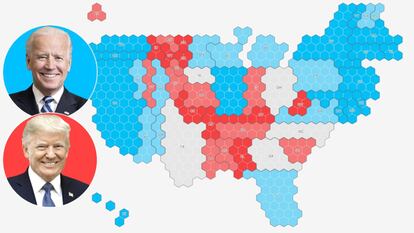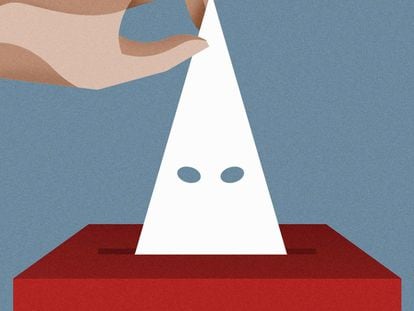How the polls are closing in the US: Trump’s options and other key points according to the surveys
Biden is the favorite and has an advantage over his Republican opponent that is greater than the one Clinton had. That said, Trump still has a one-in-six chance of winning
/cloudfront-eu-central-1.images.arcpublishing.com/prisa/5C2IBX43UFGK5HTK45Y5HTXZHI.png)
The forecast that we are updating from EL PAÍS is going to close with Joe Biden as the firm favorite. The consensus prediction gives him an 85% chance of winning, compared to the 15% that Donald Trump has. These are the key points to take away from these and other data.
The chances for Trump are smaller than those he had in 2016, when he won by surprise. Four years ago, Hillary Clinton had a 3.8% advantage in the polls, but that margin ended up being two points and she lost the election. Could this surprise be repeated? Of course. But it would be an even bigger one: Biden’s advantage over Trump is double, nearly nine points. What’s more, the number of undecided voters has fallen. Back then, 12% were undecided on whether to vote for Clinton or for Trump, but now it’s just 5%.
In 2016, the forecast model based on polls from FiveThirtyEight gave Trump a 29% chance of winning on the eve of the election and now it has reduced that to 10%. It’s a figure that needs to be read carefully: it means that another victory for the Republican would be a bigger surprise – three times more strange – but also says that it is a possibility. It could happen.
A 10 to 15% probability of an event is by no means impossible. If you wake up without knowing what day it is, it is as likely that it is Monday as a Trump victory is. These are numbers that are similar to taking a penalty in a soccer match: if you are a Democratic voter you should feel like the striker (hopeful, but scared), and if you are a Republican voter, you should feel like the goalkeeper (it’s not easy, but not all is lost). This uncertainty is not pleasant, but that’s the nature of an election.
What’s more, not all of the forecasts coincide. To make our prediction, we combined four sources: two models based on polling, the predictions of a group of experts and the betting market. The models are the most decisive: they say that Biden has a 90% or even 95% chance of winning. The group of experts is more cautious, their forecasts coincide with our average and they give him an 85% chance.
The most divergent forecasts are the bets. From the odds being set, you can deduce that Trump has a one-in-three chance of being president again (36%). This is much higher, and for the betting houses, in fact, a Trump win would not be a surprise. The betting market is very conscious of the 2016 result and doesn’t trust the polls. This is something that we saw at the French presidential elections in 2017. Then, the polls said that Marie Le Pen had few chances, but three months had passed since the Brexit and Trump wins, and a lot of people thought that the pollsters were not capturing the populist vote. On that occasion, the betting houses got it wrong and the polls were accurate.
But where are the options that Trump has? There are a dozen key states that could change hands or are representative. If we could see a result in advance, the best thing to do would be to ask about Wisconsin. If Biden wins there, his options of being president rise to 19 out of 20, according to the FiveThirtyEight statistic model. But if Trump surprises us again and takes that state, he would become the favorite with five options out of six to win. Something similar is happening with Pennsylvania, Michigan, Minnesota and Nevada.
For a Trump victory there will need to be a big surprise – which, by definition, can’t be predicted – or for the result to take a narrow path. First he needs Florida, almost by necessity, where he is a few points below Biden. Then he needs to ensure a win where he is leading – Texas, Iowa, Ohio – or prevail in disputed states such as Georgia and North Carolina. Once there, to complete this combination he has two main alternatives: repeat the path of 2016 and win some Rust Belt states – Pennsylvania, Michigan, Wisconsin, Minnesota – or take a surprise win in the west: Arizona, Nevada, New Mexico, Colorado. None of these paths is easy and that is why Biden is the favorite: he doesn’t need anything special to happen.
- Joe Biden
- Biden favorite
- Tie
- Trump favorite
- Donald Trump
Watch out for stylized narratives. On Wednesday there will be a result and we will be looking at small changes among the electorate to explain it: we will read – and write – that the suburbs have changed color, that Pennsylvania has returned to the Democrats or that non-college educated white voters have voted for Trump once more. But we have to remember that a lot of things will not change. The huge majority of those who voted for Trump will vote for him once more. We know this from the polls. If just 90% repeat their vote, Trump will likely lose the presidency, but the majority of his voters will still be there. Americans did not change all of their ideas when they voted to substitute Obama with Trump, and nor will they do so now, even if they opt for Biden. Countries are not turned on their heads from one day to the next.
Biden or Trump: Who is winning the election race?

Consult the prediction each day on this page (Spanish language).
English version by Simon Hunter.

/cloudfront-eu-central-1.images.arcpublishing.com/prisa/WRMU3KHF45BMBPCOACEDHSQCQU.jpg)











































